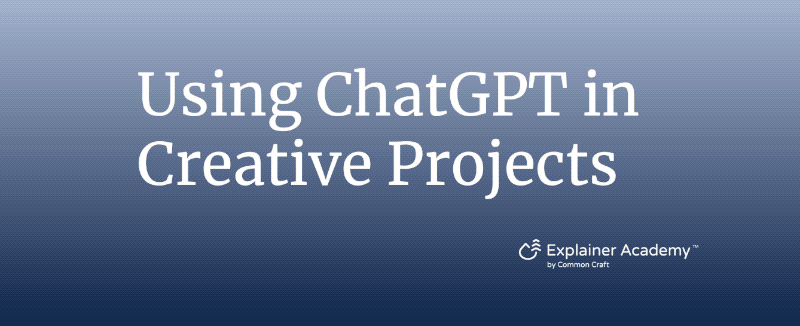This article was published in an issue of the Common Craft Newsletter. Subscribe here.
I’ve wondered if artificial intelligence, like ChatGPT, will eventually eat my lunch, so to speak. Given that I am an author, educator, and video creator, the risk seems real that AI could replace the creative work on which I've built my professional life.
Today, ChatGPT can create, analyze and summarize lengthy text, transform that text into the language of a specific demographic, and write a video script complete with suggestions for visuals, all in a matter of seconds. Needless to say, we’re living in a new reality.
Today, it can analyze and summarize lengthy text, transform that text into the language of a specific demographic, and write a video script complete with suggestions for visuals, all in a matter of seconds. Needless to say, we’re living in a new reality.
Amid the disruption, I think it’s important to understand what AI can’t do.
My career has been focused on the skill of explanation and how to design communication for a specific audience. I’d like to focus on two things that make explanations work and how they connect to AI and the human experience.
Packaging Ideas
First, let’s discuss packaging ideas. Remarkable explanations use data and facts as starting points for creativity. We ask: how can I package this information so it’s clear and understandable for my audience? Would an analogy work? A short story? This step can be frustrating because it requires inspiration and creativity. Projects sometimes need a spark to find a creative direction.
This is where generative AI, like ChatGPT, can excel. Given the right prompts, it can provide new ideas and provide multiple paths to consider. It can brainstorm with incredible speed and generate long lists of approaches, titles, themes, and more.
But that’s only part of the explanation equation.
Empathy
The second point is empathy. For that explanation to work, it must be designed around the audience’s needs. We must put ourselves in the shoes of the audience and communicate in a way that works for them. This is where humans excel. We can naturally empathize with others and adjust our communication in a way that no AI can replicate.
For Example
Imagine working in a company where it’s your job to communicate company policy. The CEO micromanages everything you do and over time, you’ve learned how to navigate her standards and write according to her expectations.
You’ve experimented with ChatGPT and it’s been helpful. You’ve had it rewrite a memo, generate suggestions for a meeting, and recommend ways to work with a micromanager.
But it can’t write for your boss. It doesn’t know your boss. It can’t understand your relationship with her. It doesn’t know what makes her happy, how she feels, or what worries she has. It doesn’t know her ambitions or aspirations. Only you, the human, can know these things.
This is true in multiple contexts.
- AI can help you do research and generate ideas for a conference presentation, but it can’t know the people in the audience, or what they need.
- AI can help teachers develop lesson plans and find creative activities, but it can’t know what will delight that specific group of students.
- AI can help an architect develop designs for a home, but it can’t know the homeowner’s attitudes and desires.
My point is this: AI is a powerful and inspirational tool. It can jumpstart creative projects. But the human touch, in the form of empathy, is required for truly effective communication. This has always been the secret sauce of explanations and that hasn’t changed.
In my book, The Art of Explanation, I wrote that “Facts give stories substance. Stories give facts meaning.” You can think of AI as a (sometimes untrustworthy) fact and idea machine. It provides the substance and often, that’s not enough. Our task is to package that substance into meaning for our audience by applying the most human of traits: empathy for our audience.
The animated gif below is a succinct summary of this idea. This gif is also an example of a Readable Video that took about an hour to create.
